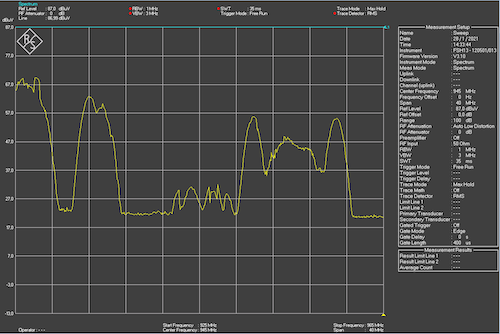Spectrum analysis of high frequency
Frequency-selective measurement of high-frequency (HF) immissions
In the generally more frequently used method of RF imaging, the so-called broadband measurement, the sum of all RF immissions present at the time of measurement can be recorded, as well as an acoustic signal characteristic of the respective mobile radio service.
Depending on the task for investigating a residential or sleeping area, it may be necessary to record detailed information on the high-frequency immissions, e.g. which radio service is involved, what signal strength is present and what permanent minimum and maximum RF immissions can be expected at the measurement point. This information can be collected by the so-called frequency-selective spectrum analysis, in which all mobile radio services present at the time of the measurement are determined separately.
In a first overview measurement of the spectrum analysis, it is shown in which frequency ranges an RF-immission is present. Subsequently, the respective radio service is measured in frequency and signal strength (detailed spectrum), from which the permanently existing base load (minimum load) as well as the maximum full load (max peak or worst case) of the transmitter can be determined. With the help of predefined correction factors, the different bandwidths of the respective mobile radio services are taken into account and extrapolated to the maximum power. From the maximum transmission power (MaxPeak), the minimum load can now be calculated (base load).
The total immission of all mobile radio services determined at the measuring point is formed from the sum of the detail spectra and specified in the radiation density (power flux density) in microwatts per square metre (μW/m2). A frequency-selective spectrum analysis is generally recommended for the planning of a remediation measure for the shielding (attenuation) of high-frequency immissions.
The broadband measurement technique
Sum measurement of high-frequency immissions
Unlike spectrum analysis, broadband measurement is only sum-based, i.e. only the total sum of the high-frequency immissions detected by the device is indicated. The problem here, however, is that a broadband device cannot distinguish between the respective radio services, but these can be present with very different bandwidths in the same frequency range (GSM/LTE).
However, the bandwidths of the respective mobile radio service must be taken into account to determine the high-frequency immission. Thus, when measuring an RF immission by means of a broadband measuring device, an underestimation can occur, which can amount to a factor of 100. Therefore, broadband measurement is not suitable for determining an RF immission caused by different mobile radio services or for planning a remediation measure to shield radio frequency.
The broadband measurement technique is well suited for “in-house” source detection, but can also be used for long-term recording of RF immissions. Long-term broadband measurements can also be useful if the expected RF immissions cannot be detected at the time of a spectrum analysis because the source is located outside one’s own sleeping/living area and may not be transmitting continuously.
For a concept for the shielding of RF immissions, a long-term RF measurement is usually not necessary, since the minimum and maximum exposure determined by the spectrum analysis provides the framework for the shielding effectiveness of a shielding material required to comply with international recommendations.



